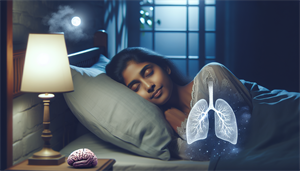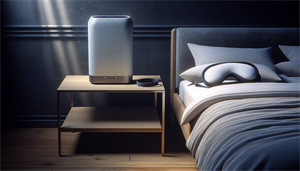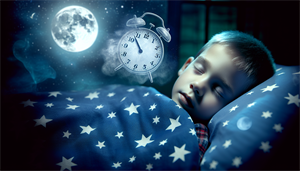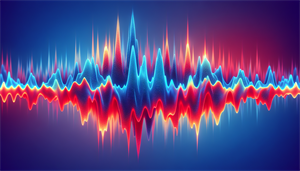When it comes to sleep disorders, sleep apnea is a formidable foe. It lurks in the silent hours of the night, stealing breaths and disrupting the peaceful slumber that our bodies need to restore and rejuvenate. But what is sleep apnea, exactly? More importantly, how can one recognize its symptoms, understand its risks, and most crucially, manage it effectively? Let’s dive in.
Key Takeaways
-
Sleep Apnea is a condition characterized by airway obstruction and communication issues between the brain and muscles.
-
Symptoms include snoring, gasping for air, daytime fatigue, interrupted sleep and mouth breathing in children.
-
Treatment options involve positive airway pressure therapy as well as lifestyle changes such as maintaining a healthy weight to effectively manage symptoms.
Understanding the Two Main Types of Sleep Apnea

Sleep apnea is a type of sleep disorders that occurs when an individual’s breathing is intermittently interrupted during sleep. The two primary classifications of sleep apnea are obstructive sleep apnea and central sleep apnea, each of which has its own distinct causes and symptoms. So, how is sleep apnea diagnosed and treated? It depends on the type and severity of the condition.
Obstructive sleep apnea, the more common of the two, is caused by physical blockage of the airway due to relaxation of the throat muscles during sleep, resulting in disconcerting symptoms like snoring and gasping. On the other hand, central sleep apnea is attributed to a breakdown in communication between the brain and the muscles that control breathing. This leads to slow, shallow breathing, which can range from mild to severe.
Obstructive Sleep Apnea
Obstructive sleep apnea dominates as the most frequently encountered sleep apnea variant, resulting from airway obstruction during sleep. Symptoms like sleep apnea snores and gasping characterize this condition, commonly interrupting sleep and leading to daytime drowsiness.
The primary cause of obstructive sleep apnea is the slackening of throat muscles during sleep, narrowing the available space for air circulation. Obstructive sleep apnea occurs when this results in the narrowing or closure of the airway during inhalation, leading to a reduction in oxygen levels in the bloodstream and intermittent awakenings to reestablish the airway. This cycle may occur 5 to 30 times or more per hour, causing:
-
excessive daytime sleepiness
-
loud snoring
-
gasping or choking during sleep
-
morning headaches
-
difficulty concentrating
-
irritability
If you suspect you have sleep apnea, it is important to consult with a healthcare professional, such as a sleep specialist, to get sleep apnea diagnosed and discuss treatment options.
Central Sleep Apnea
Unlike obstructive sleep apnea, central sleep apnea involves breathing disruptions due to issues with brain-muscle communication. The brain fails to transmit signals to the breathing muscles, leading to slow and shallow breathing during sleep.
People dealing with central sleep apnea often experience the following symptoms:
-
Waking up gasping for air
-
Struggling to initiate or sustain sleep
-
Waking up frequently during the night
-
Daytime sleepiness and fatigue
Despite being less common than obstructive sleep apnea, central sleep apnea can range from mild sleep apnea to severe sleep apnea cases and requires proper diagnosis and treatment.
Recognizing the Symptoms of Sleep Apnea
Identifying sleep apnea symptoms is crucial for pursuing the right course of treatment. Nocturnal symptoms include:
-
Loud snoring
-
Instances of breathing cessation during sleep
-
Nocturnal awakenings with gasping or choking
-
Waking up with a parched or sore throat
Subtle daytime symptoms of sleep apnea can include:
-
Waking up with a dry mouth or scratchy throat
-
Morning headaches
-
Experiencing fatigue
-
Declining performance at work or school
-
Mood changes
-
Behavioral issues
Recognizing these symptoms and consulting a healthcare provider is essential to treat sleep apnea effectively.
Risk Factors Associated with Sleep Apnea
Specific factors heighten the likelihood of sleep apnea onset for people with sleep apnea. Obesity is one such significant factor. Surplus body weight can constrict the upper air passages, leading to their collapse and reduced neuromuscular function during sleep.
Age is another factor that increases the risk of developing sleep apnea. This is primarily due to weight gain and changes in the structure of the airways. Additionally, older adults may be more vulnerable to other health conditions that can elevate the risk of sleep apnea, including cardiovascular disease and diabetes.
The higher prevalence of sleep apnea in men can be attributed to their larger neck circumferences and longer pharyngeal airways, which can increase the risk of airway collapse during sleep.
The Importance of Accurate Diagnosis
Precise diagnosis is key to identifying the form and intensity of sleep apnea. The initial step in assessing sleep apnea involves reviewing the individual’s symptoms and overall health, as well as conducting a physical examination.
While symptoms can contribute to the diagnosis and assist in assessing the seriousness of the condition, testing is necessary to confirm the presence of sleep apnea. Polysomnography, a type of sleep study, is considered the most dependable form for diagnosing sleep apnea. However, an at-home sleep study is not utilized for diagnosing central sleep apnea.
Treatment Options for Sleep Apnea

A variety of treatments exist for sleep apnea, including sleep apnea treated with:
-
Positive airway pressure therapy
-
Oral appliances
-
Surgery
-
Lifestyle modifications
These options can prevent apnea events or decrease their frequency and severity, resulting in improved rest and overall health.
Positive Airway Pressure Therapy

Positive airway pressure therapy has gained wide acceptance as a successful remedy for sleep apnea. It involves the use of devices like CPAP machines to uphold open airways during sleep, thereby swiftly preventing airway blockages that lead to sleep apnea.
Positive Airway Pressure therapy, particularly CPAP, functions by providing a continuous stream of air pressure to the airway while the individual is asleep. This serves as a pneumatic splint to prevent the upper airway from collapsing and to uphold its patency. Consequently, this approach diminishes or eradicates instances of apnea and hypopnea, thereby treating the underlying cause of sleep apnea.
Oral Appliances and Surgery
Oral appliances present another alternative for tackling sleep apnea. These specialized mouthpieces are designed to maintain the position of the jaw and tongue in a way that alleviates pressure on the windpipe, effectively addressing sleep apnea.
While the effectiveness of oral appliances varies, with success rates ranging from 52% to 88%, they offer certain advantages. They serve as an alternative treatment for individuals with mild to moderate sleep apnea, are cost-effective, require reduced equipment, and are portable. However, they can also have certain disadvantages such as the potential for temporomandibular (TMJ) pain and changes in bite, increased saliva production, dry mouth, gum tissue tenderness, slight discomfort, jaw pain, and sore teeth.
Lifestyle Changes and Self-Care
Alterations in lifestyle contribute significantly to managing sleep apnea symptoms, with the potential to augment the patient’s health and possibly lessen symptom severity. Specific lifestyle modifications that can help in managing sleep apnea include:
-
Weight loss
-
Increased physical activity
-
Cessation of smoking and alcohol consumption
-
Avoidance of certain medications
-
Improved sleep hygiene practices
Exercises can also be advantageous for individuals with sleep apnea. Here are some exercises that can improve breathing by opening and strengthening the airway muscles, helping the throat muscles relax:
-
Tongue stretches
-
Tongue push-ups
-
Tongue wags
-
Spoon hold
-
Jaw stretches
-
Singing
-
Yogic breathing
Potential Complications of Untreated Sleep Apnea
Untreated sleep apnea can inflict long-term damage on heart health, increasing the risk of heart attacks, arrhythmias, and cardiovascular disease. Additionally, it is linked to hypertension, stroke, and coronary artery disease.
In addition to high blood pressure and heart health issues, untreated sleep apnea may result in significant complications such as daytime fatigue, concentration problems, and an increased risk during surgery.
Sleep Apnea in Children

Sleep apnea isn’t exclusive to adults; children can also be affected. While the symptoms might not be as noticeable in children as in adults, red flags to look out for include:
-
Snoring
-
Mouth breathing
-
Restless sleep
-
Behavioral problems
The prevalence rate of sleep apnea in children varies, with most studies reporting a figure between 1% and 4%. However, in certain clinical conditions, it can be significantly higher. Untreated sleep apnea in children may result in a range of risks and complications, such as:
-
Stunted growth
-
Behavioral and learning difficulties
-
Impaired growth
-
Cognitive delays
-
Cardiovascular issues
-
Heightened susceptibility to conditions like enuresis, attention-deficit disorder, and behavior problems.
Summary
Sleep apnea is a serious condition that requires our attention. Recognizing its symptoms, understanding its risks, and knowing how to manage it effectively is crucial. While the journey may seem daunting, remember, it is not insurmountable. Armed with knowledge and the right tools, we can combat sleep apnea and claim back our peaceful nights of restful, restorative sleep.
Frequently Asked Questions
Can you fix sleep apnea?
Yes, you can improve sleep apnea through lifestyle changes such as weight loss, physical activity, and quitting smoking and drinking. However, CPAP therapy is still the gold standard for treatment.
Does sleep apnea go away?
No, sleep apnea is a chronic condition that cannot be cured entirely. However, its symptoms can be treated with oral appliances, CPAP machines, or other forms of sleep apnea therapy.
What should I do if I think I have sleep apnea?
If you suspect you have sleep apnea, it's important to contact your doctor for an evaluation and possible referral to a sleep specialist. Seek medical advice to determine whether you need testing and treatment for sleep apnea.
What is sleep apnea?
Sleep apnea is a sleep disorder characterized by intermittent interruptions in breathing during sleep, with obstructive and central sleep apnea being the two primary classifications.
How is sleep apnea diagnosed?
Sleep apnea is diagnosed by reviewing symptoms, conducting a physical exam, and suggesting additional tests like a sleep study or polysomnography. These tests help determine the severity and appropriate treatment for the condition.


